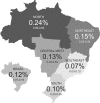HIV prevalence and sexual behavior among young male conscripts in the Brazilian army, 2016
- PMID: 29794600
- PMCID: PMC5991542
- DOI: 10.1097/MD.0000000000009014
HIV prevalence and sexual behavior among young male conscripts in the Brazilian army, 2016
Abstract
Since 1996, the Brazilian Department of Sexually Transmitted Infections (STI), AIDS and Viral Hepatitis (Departamento de Vigilância, Prevenção e Controle das IST, do HIV, AIDS e Hepatites Virais, Secretaria de Vigilância em Saúde, Ministério da Saúde) in collaboration with the Brazilian Ministry of Defense has conducted periodic and anonymous probability sample surveys to determine the human immunodeficiency virus (HIV) prevalence, the sexual and risk behaviors among conscripts of the Brazilian army. This study aimed to estimate the HIV seroprevalence of conscripts in Brazil by geographic region and to describe behavior in relation to the risk of HIV transmission by analyzing data from the Brazilian Conscripts Survey 8th edition performed in 2016.Conscripts were selected with a 2-stage sampling method stratified by geographical region. The study included a self-reported questionnaire and blood collection for HIV, hepatitis, and syphilis testing. Data from 37,282 conscripts between 17 and 22 years of age were analyzed. Of these conscripts, 73.7% stated that they were sexually active. The overall country-wide prevalence of HIV was 0.12%. The geographic prevalence rates were as follows: north (0.24%), northeast (0.15%), central-west (0.13%), southeast (0.07%), and south (0.10%). The proportion of conscripts who reported having sex with other men was 4.4%, and the estimated HIV prevalence in this group was 1.32%. Regarding prophylaxis use, 45.6% of the participants reported consistent condom use with casual partners within the last year, and 34.5% reported condom use with steady partners within the last year. The independent factors associated with HIV infection were: MSM status (odds ratio [OR] = 14.62; P = .000) and having more than 10 partners over their lifetime (OR = 3.32; P = .028).Our data suggest that the HIV prevalence among young men in Brazil remains stable except for the north region, and MSM continue to be associated with a high risk for HIV infection at a rate that is approximately 13-fold higher than the rate among men without a history of sex with another man. Our findings confirm the need to scale up combination HIV prevention for young men, including MSM, in Brazil.
Conflict of interest statement
The authors have no conflicts of interest to disclose.
Figures
References
-
- Brazilian Ministry of Health. Secretariat of Health Surveillance Department of STI Aids and Viral Hepatitis. The Brazilian Response to HIV and AIDS. Global AIDS Reponse Progress Reporting (GARPR) [Internet]. Brasília, DF: Brazilian Ministry of Health; 2015. Available from: http://www.unaids.org/sites/default/files/country/documents/BRA_narrativ.... Accessed October 25, 2017.
-
- Brasil. Ministério da Saúde. Secretaria de Vigilância em Saúde. Departamento de DST Aids e Hepatites Virais. Boletim Epidemiológico - HIV·AIDS. Ano V, n° 1. [Internet]. Brasília; 2016. 64p p. Available from: http://www.aids.gov.br/pt-br/pub/2016/boletim-epidemiologico-de-aids-2016. Accessed October 19, 2017.
-
- Szwarcwald CL, de Andrade CLT, Pascom ARP, et al. HIV-related risky practices among Brazilian young men, 2007. Cad Saude Publica (Internet) 2011;27(Suppl 1):S19–26. - PubMed
MeSH terms
LinkOut - more resources
Full Text Sources
Other Literature Sources
Medical


